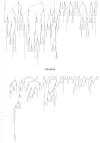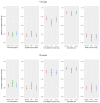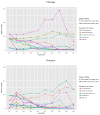Statistical adjustment of network degree in respondent-driven sampling estimators: venue attendance as a proxy for network size among young MSM
- PMID: 29910531
- PMCID: PMC6001287
- DOI: 10.1016/j.socnet.2018.01.003
Statistical adjustment of network degree in respondent-driven sampling estimators: venue attendance as a proxy for network size among young MSM
Abstract
We introduce a new venue-informed network degree measure, which we applied to respondent-driven sampling (RDS) estimators. Using data collected from 746 young MSM in 2014-2016 in Chicago, IL, and Houston, TX, we estimated the population seroprevalence of HIV and syphilis and risk/protective behaviors, using RDS estimates with self-reported network size as a standard degree measure as well as our proposed venue-informed degree measure. The results indicate that the venue-informed degree measure tended to be more efficient (smaller variance) and less biased than the other measure in both cities sampled. Venue attendance-adjusted network size may provide a more reliable and accurate degree measure for RDS estimates of the outcomes of interest.
Keywords: HIV; Respondent-driven sampling method (RDS); pre-exposure prophylaxis (PrEP); risky sexual behavior; sexually transmitted infections; two-mode affiliation networks; venue affiliation; young men who have sex with men (MSM).
Conflict of interest statement
Conflict of interest: None declared
Figures





Similar articles
-
Sampling Key Populations for HIV Surveillance: Results From Eight Cross-Sectional Studies Using Respondent-Driven Sampling and Venue-Based Snowball Sampling.JMIR Public Health Surveill. 2017 Oct 20;3(4):e72. doi: 10.2196/publichealth.8116. JMIR Public Health Surveill. 2017. PMID: 29054832 Free PMC article.
-
Respondent-Driven Sampling in a Multi-Site Study of Black and Latino Men Who Have Sex with Men.J Natl Med Assoc. 2016 Feb;108(1):69-76. doi: 10.1016/j.jnma.2015.12.009. J Natl Med Assoc. 2016. PMID: 26928490 Free PMC article.
-
Acceptability of pre-exposure prophylaxis for HIV prevention: facilitators, barriers and impact on sexual risk behaviors among men who have sex with men in Benin.BMC Public Health. 2020 Aug 20;20(1):1267. doi: 10.1186/s12889-020-09363-4. BMC Public Health. 2020. PMID: 32819335 Free PMC article.
-
HIV seroprevalence, risk behaviors, and cognitive factors among Asian and Pacific Islander American men who have sex with men: a summary and critique of empirical studies and methodological issues.AIDS Educ Prev. 1998 Jun;10(3 Suppl):31-47. AIDS Educ Prev. 1998. PMID: 9642429 Review.
-
The development of respondent-driven sampling (RDS) inference: A systematic review of the population mean and variance estimates.Drug Alcohol Depend. 2020 Jan 1;206:107702. doi: 10.1016/j.drugalcdep.2019.107702. Epub 2019 Nov 1. Drug Alcohol Depend. 2020. PMID: 31761476
Cited by
-
Anal human papillomavirus (HPV) disagreement by Linear Array compared to SPF10 PCR-DEIA-LiPA25 system in young sexual minority men.Heliyon. 2024 Jun 3;10(11):e32336. doi: 10.1016/j.heliyon.2024.e32336. eCollection 2024 Jun 15. Heliyon. 2024. PMID: 38933939 Free PMC article.
-
Network overlap and knowledge of a partner's HIV status among young men who have sex with men.AIDS Care. 2019 Dec;31(12):1533-1539. doi: 10.1080/09540121.2019.1601672. Epub 2019 Apr 1. AIDS Care. 2019. PMID: 30935221 Free PMC article.
-
Prevalence, Incidence, and Predictors of Kaposi Sarcoma-Associated Herpesvirus Infection Among Young Men Who Have Sex With Men in the Southern United States.J Infect Dis. 2024 May 15;229(5):1387-1392. doi: 10.1093/infdis/jiad384. J Infect Dis. 2024. PMID: 37711067 Free PMC article.
-
Social networks, high-risk anal HPV and coinfection with HIV in young sexual minority men.Sex Transm Infect. 2022 Dec;98(8):557-563. doi: 10.1136/sextrans-2021-055283. Epub 2022 Feb 19. Sex Transm Infect. 2022. PMID: 35184046 Free PMC article.
-
Integrated molecular and affiliation network analysis: Core-periphery social clustering is associated with HIV transmission patterns.Soc Networks. 2022 Jan;68:107-117. doi: 10.1016/j.socnet.2021.05.003. Epub 2021 May 23. Soc Networks. 2022. PMID: 34262236 Free PMC article.
References
-
- Auerbach DM, Darrow WW, Jaffe HW, Curran JW. Cluster of cases of the acquired immune deficiency syndrome: Patients linked by sexual contact. American Journal of Medicine. 1984;76:487–492. - PubMed
-
- Boodram B, Williams CT. Collecting whole network data for human immunodeficiency virus prevention: A review of current strategies. Journal of AIDS and HIV Research. 2013;5(4):114–126.
-
- Clark J, Konda K, Silva-Santisteban A, Peinado J, Lama J, Kusunoki L, … Sebastian J. Sampling methodologies for epidemiologic surveillance of men who have sex with men and transgender women in Latin America: An empiric comparison of convenience sampling, time space sampling, and respondent driven sampling. AIDS and Behavior. 2014;18(12):2338–2348. - PMC - PubMed
Grants and funding
LinkOut - more resources
Full Text Sources
Other Literature Sources
Miscellaneous
